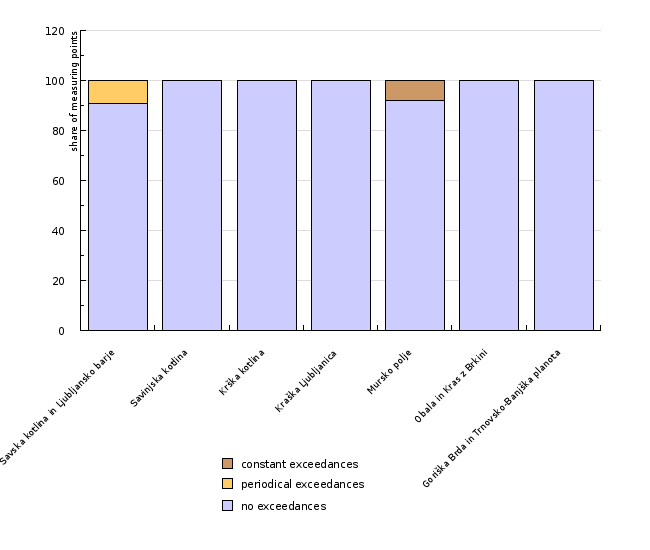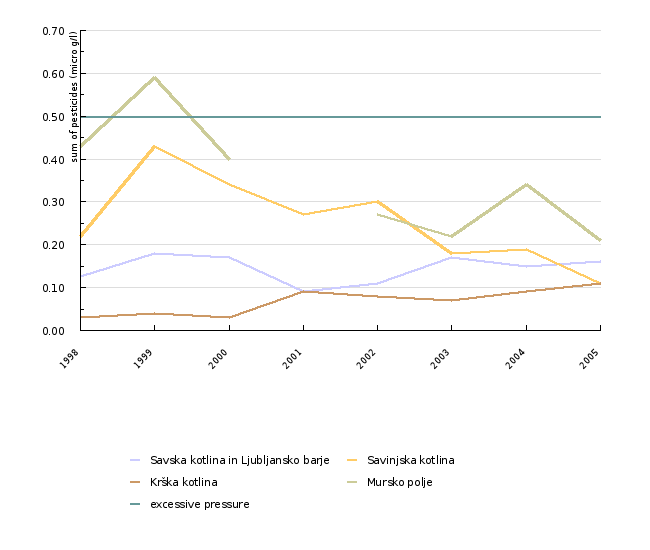[VD06] Pesticides in groundwater

Definition
Pollution of groundwater by pesticides is represented by the share of sampling points in aquifers with inter-granular and karst-fracture porosity where threshold values of concentrations of individual pesticides and the sum of pesticides, respectively, in samples taken were exceeded at all times, occasionally or never.
The threshold values concerning pesticide concentrations in groundwater in Slovenia as determined in the Decree on the Quality of Underground Water (OJ RS No 11/02) is 0.06 µg/l for individual pesticides, 0.1 µg/l for atrazine and desethyl-atrazine, and 0.5 µg/l for the sum of pesticides.
Charts
Standardised Database for Water Quality Monitoring, Environmental Agency of the Republic of Slovenia, 2007
| Savska kotlina in Ljubljansko barje | Savinjska kotlina | Krška kotlina | Kraška Ljubljanica | Mursko polje | Obala in Kras z Brkini | Goriška Brda in Trnovsko-Banjška planota | ||
|---|---|---|---|---|---|---|---|---|
| total | number | 33 | 13 | 11 | 2 | 12 | 3 | 9 |
| no exceedances | number | 30 | 13 | 11 | 2 | 11 | 3 | 9 |
| no exceedances | % | 91 | 100 | 100 | 100 | 92 | 100 | 100 |
| periodical exceedances | number | 3 | 0 | 0 | 0 | 0 | 0 | 0 |
| periodical exceedances | % | 9 | 0 | 0 | 0 | 0 | 0 | 0 |
| constant exceedances | number | 0 | 0 | 0 | 0 | 1 | 0 | 0 |
| constant exceedances | % | 0 | 0 | 0 | 0 | 8 | 0 | 0 |
Standardised Database for Water Quality Monitoring, Environmental Agency of the Republic of Slovenia, 2007
| 1998 | 1999 | 2000 | 2001 | 2002 | 2003 | 2004 | 2005 | ||
|---|---|---|---|---|---|---|---|---|---|
| Savska kotlina in Ljubljansko barje | micro g/l | 0.13 | 0.18 | 0.17 | 0.09 | 0.11 | 0.17 | 0.15 | 0.16 |
| Savinjska kotlina | micro g/l | 0.22 | 0.43 | 0.34 | 0.27 | 0.3 | 0.18 | 0.19 | 0.11 |
| Krška kotlina | micro g/l | 0.03 | 0.04 | 0.03 | 0.09 | 0.08 | 0.07 | 0.09 | 0.11 |
| Mursko polje | micro g/l | 0.43 | 0.59 | 0.4 | 0.27 | 0.22 | 0.34 | 0.21 |
Goals
The National Environmental Protection Programme provides for a reversal of groundwater pollution by pesticides.
The following legislation represents a legal basis for the attainment of the said objective: the Decree on the Quality of Underground Water (OJ RS No 11/02), the Decree on the Designation of the Status of Endangerment Due to Phytopharmaceuticals to Areas of Aquifers and Their Drainage Basins and on the Integrated Rehabilitation Measures (OJ RS No 97/02), the Ordinance on the Areas of Aquifers and Their Drainage Basins Endangered Due to Phytopharmaceuticals (OJ RS No 97/02), the Rules on Drinking Water Quality (OJ RS No 46/97, 54/98 and 7/00) and the Council Directive 98/83/EC on the Quality of Water Intended for Human Consumption.
Comment
In 2004, the arithmetic mean values designated for the sum of pesticides did not exceed the threshold value (0.5 µg/l) in the groundwaters of any observed areas. In the period from 1993 to 2004, a reducing trend in the sum of pesticides was monitored at aquifers located at the Mura River (Mursko polje) and the Savinja River (Lower Savinja Valley – Bolska Valley). The contents of the sum of pesticides at Ljubljansko polje and Krško-Brežiško polje appear to have been within permissible levels in the period from 1993 to 2004. Concerning the karst-fracture aquifers, pesticide contents are below the identifiable level of analytical methods. The highest share of threshold value exceedances at sampling points was established for atrazine and its metabolite desethyl-atrazine. The share of sampling points where the concentration of the aforementioned pesticides exceeded the threshold values determined in legislation is higher in Slovenia in comparison with the European average.
Methodology
The quality of groundwater in Slovenia is monitored within the framework of the national monitoring of groundwater, springs and surface waters (Ministry of the Environment and Spatial Planning, Environmental Agency of the Republic of Slovenia). Pollution of shallow-water alluvial aquifers (populated and agricultural areas) and karst-fracture aquifers, where pollution is lower due to different land-use, is monitored.
Groundwater bodies are selected according to the intermediate phase, i.e. phase II intended for the determination of such bodies. Representation of individual types of aquifers in the area of water supply was also taken into consideration, and constitutes 60% of population as regards alluvial aquifers and 40% of population as regards karst-fracture aquifers. For the purpose of representation of the indicator, the proposed groundwater bodies indicated here below were taken into consideration: Prekmursko-Mursko polje (10 sampling points, alluvial) and Bolska Valley and Lower Savinjska Valley (13 sampling points, alluvial), Ljubljansko polje (10 sampling points, alluvial), Krško-Brežiško polje (12 sampling points, alluvial), Trieste-Kvarner Gulf watershed (1 sampling point, karst), Karst Ljubljanica River (2 sampling points, karst) and Trnovsko-Banjška Plateau-Hrušica (4 sampling points, karst).
The following are sampling points for nitrates: drinking water pumping stations (33.3%), industrial wells (8.9%), common facilities for water quantity and quality monitoring (42.2%) and facilities for water quality monitoring (15.6%). 52 sampling points (wells, drilling wells, springs) were taken into consideration for the purposes of representation of this indicator. Samplings were conducted 2-6 times a year.










